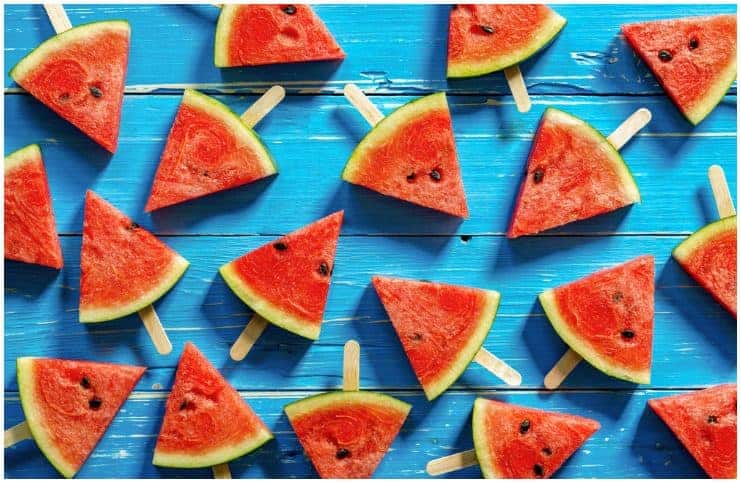How to Pick a Ripe Watermelon at the Grocery Store:
Watermelons! Yum! Everyone loves this giant juicy sweet fruit (or is it a vegetable), even kids who are fussy eaters usually love chunks of watermelon. The average American diet includes roughly 14 pounds of watermelon a year, according to the USDA.
Watermelon is an excellent source of Vitamin-A (in the form of carotenoids), which is a powerful natural antioxidant. 100 g of fresh fruit provides 569 mg or 19 percent of the daily required levels of this vitamin.
Additionally, the health benefits of watermelon include providing vitamin C, which has been proven to protect bones and cartilage, used in repairing ligaments and tendons, and help speed wound healing and scar tissue.
It is also rich in anti-oxidant flavonoids like beta-carotene, zeaxanthin, lycopene, lutein, and cryptoxanthin. These healing antioxidants have been found to offer protection against prostate, colon, lung, breast, endometrial, and pancreatic cancers.
It is extremely difficult to tell if a watermelon is ripe by just looking; it must be examined.
Note – unlike honeydews and cantaloupes, watermelons don’t continue to ripen once they’re cut off the vine.
There are several clues that the fruit and plants give, but none is a guarantee. Learn here how to tell if a watermelon is ripe:
Sound
You’ve probably seen people knocking or tapping on watermelons in the store. This has always been a popular way to detect ripeness, but some say it takes years of experience to detect the correct sound, plus, this test is pretty subjective and is only effective when comparing one watermelon to another.
A ripe and sweet melon should have a nice, deep sound, more like a drum or a knock on a door. The higher and flatter the sound, the less ripe the melon.
Underside
The underside should have a creamy yellow spot from where it sat on the ground and ripened in the sun – rather than being picked early.
The Look
This applies to honeydew melons too. When buying a watermelon, you should look for “a firm, symmetrical watermelon that is free of bruises, cuts or dents” – (meaning it has enough sun and water), according to the National Watermelon Promotion Board.
Color Check
This method of determining ripeness also takes practice. Take notice of the color of its skin. Watermelons have a shiny, bright green color on the outside as they grow; when the fruit matures, this coloring will dull.
Heavy For Its Size
At 92 percent water, a good melon should feel heavy for its size. A light-feeling melon means the insides have begun to dry out.
Tendrils
The tendrils of the watermelon do more than provide it with sustenance, they act like a timer, indicating when the fruit is ripe. Sometimes known as the “pigtail” because of its curly shape, it will dry out and die, indicating maturity.
So, inspect the tendril. Honeydew melons, cantaloupes, and other small melons do not produce tendril-like watermelons so this clue is absent.
Tiny Holes
When buying a watermelon from a farmer’s market, check the melon for any tiny holes in small clusters anywhere on the skin. This signifies that bees were burrowing and trying to get to the sweetness inside. If there is an expert out there on the sweetness of this fruit, it’s the bee.
Eat In The Season
For most of the countries, the melon season starts in late July but August is the peak, making them a perfect summer choice in the northern hemisphere. If you insist on buying watermelons in January, you’re on your own!
Tip Cor Cantaloupe
As for cantaloupe: don’t touch, don’t look, just smell. Ripe cantaloupe smells very nice and sweet. Sniffing out the most aromatic one is the smartest way to pick a cantaloupe or honeydew.
How To Store Watermelons
If a watermelon was cold when you bought it, keep it cold by storing it in the refrigerator. If not, it’s fine to leave the whole watermelon out at room temperature.
Once cut, store the fruit in the fridge. Either wrap cut edges with plastic wrap or store cubed fruit in a sealed container. And remember, store-cut watermelon for 2-3 days to prevent it from getting gritty. Never store a watermelon below 40 °F (4 °C), as this causes chilling injury to the fruit.
READ THIS NEXT:
High and Low Histamine Foods List
Feijoa (Acca sellowiana) – Side Effects
Warnings of Consuming Excessive Green Tea
References https://www.researchgate.net/publication/269493620_A_Study_on_Watermelon https://www.ncbi.nlm.nih.gov/pmc/articles/PMC4464475/
